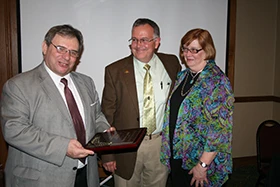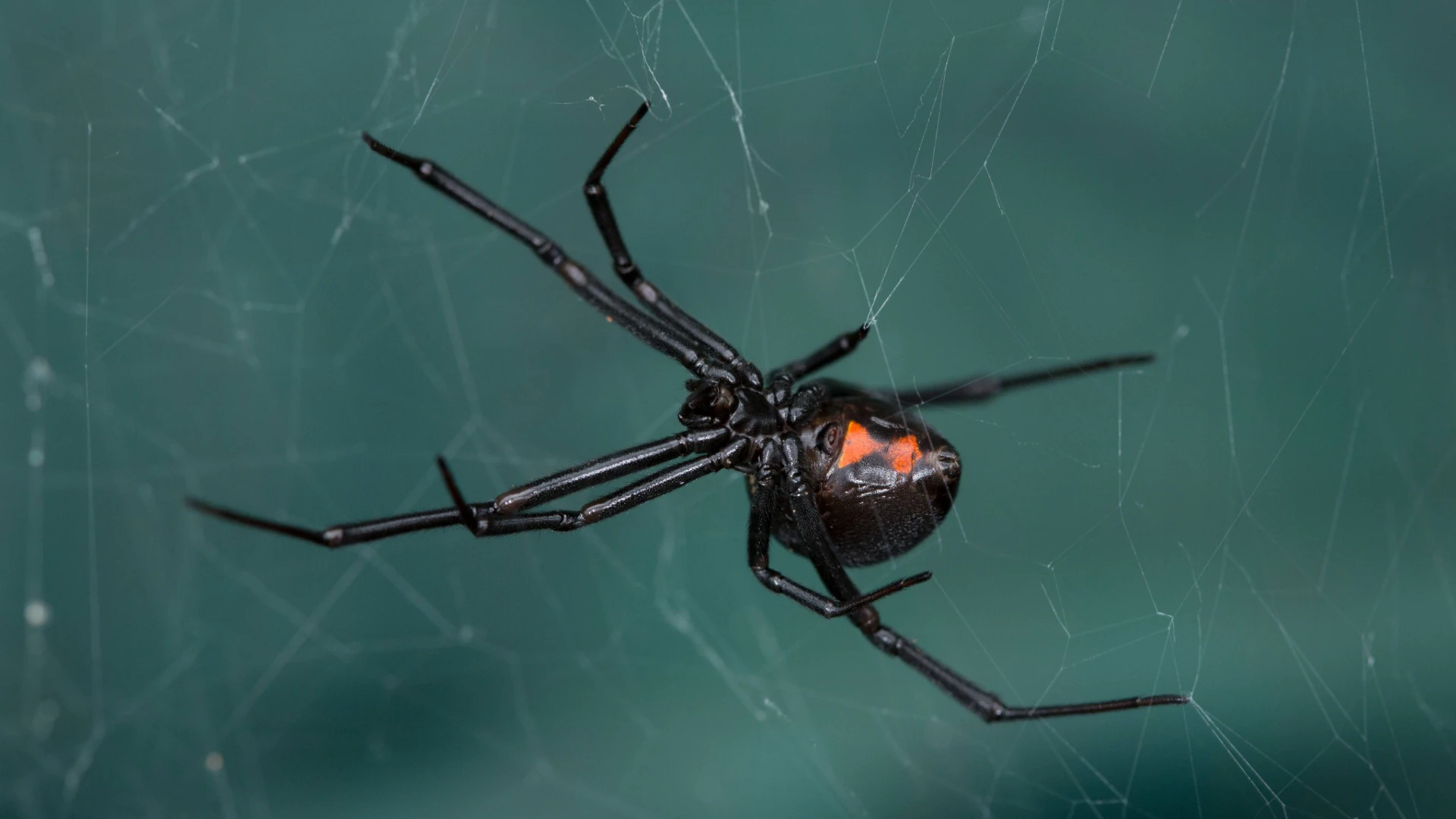
CLEVELAND, Ohio – Dr. Gerry Wegner, technical director, Varment Guard Environmental Services, thought he was the featured speaker at the Greater Cleveland Pest Control Association (GCPCA) Annual Awards Banquet and little more. But when his wife, Debbie, walked through the door and sat down to have dinner with his Varment Guard colleagues he thought: “What is she doing here?”
An hour later he got his answer. Wegner, a 30+ year veteran of the pest management industry, was presented the Tom Evans Award, the GCPCA’s highest honor, by Rich Kozlovich, who was sitting in as master of ceremonies for the event since GCPCA President Molly Patton was ill.
In presenting the award to one of the most humble and hard-working men in the pest management industry, Kozlovich said, “Some people have done things year after year after year and we have failed to appreciate it. This year’s recipient, Dr. Gerry Wegner, is that kind of person.”
Not only has the Ohio State University graduate and Copesan Technical Committee member generously shared his expertise with the industry whenever asked, but in his spare time he has created dozens of “bug clocks” featuring mounted insect specimens that he has donated for various fund-raising purposes to Purdue University, Pi Chi Omega, the Ohio Pest Management Association Scholarship Fund, and other worthy organizations.
Not surprisingly, in accepting the award, Wegner deflected the credit for his personal and financial contributions to others, stating “it is your generosity as an industry that has made all of this possible.”
In all, 30 individuals have been recognized with the Tom Evans Award, named after the longtime president of Southern Mill Creek Products, which was acquired by Univar in 2010.
Kozlovich said the annual banquet “truly celebrates the industry” and the Tom Evans Award ceremony recognizes “individuals or groups who have made sacrifices of their time and energy and talent for the good of the pest control industry.” Past recipients of the award and the year they were honored include:
1996 – Carl Hinderer
1997 – Lonnie Alonso
1998 – Pest Control Magazine and PCT Magazine
1999 – John Patton
2000 – Jim Steckel and John Gedeon, Sr.
2001 – Chuck Kettler
2002 – Bettie Portwood
2003 – Ohio Pest Control Association Wood-Destroying Impact (WDI) Report Committee: Carl Hinderer, Ron Belknap, Lonnie Alonso and John Moran
2004 – Bob Caldwell, William L. Kirchner and George Ross
2005 – Jim Betts
2006 – John Gedeon, Jr.
2007 – Steve Scherzinger
2008 – Mike Grace
2009 – Ron Belknap
2010 – Scott Steckel
2011 – Belinda Jones, Capitol Consulting Group, Executive Director of OPARR
2012 – Andrew Christman
2013 – Ohio Pest Control Association Nuisance Wild Animal Control Committee: Belinda Jones, Andrew Christman, Lonnie Alonso, Scott Steckel and Mike Faler. Rich Kozlovich also was recognized with a Tom Evans Award.
2014 – Gerry Wegner
In addition to receiving the Tom Evans Award, Wegner gave an informative educational presentation on occasional invaders, sharing his insights about the biology and control of a broad range of pests encountered by PMPs around structures. Among his observations:
• Yellow sac spiders: “They are tolerated in my house, but most customers don’t feel that way about them do they?”
• Jumping spiders: “Some people (mistakenly) think they have black widows. These guys are good at scaring people.”
• House centipedes: “They’re sometimes called ‘the running eyelash.’ They are found close to homes with complicated landscape. These things thrive in that layered construction.”
• Wood cockroaches: “The males fly towards lights at night.”
• Sowbugs: “Once indoors they soon die from dehydration or desiccation.”
• Earwigs: “They’re good climbers. They can bridge over the gutter line of structures.”
Scott Steckel, a member of the NPMA Board of Directors, updated attendees on the latest developments at the Washington, D.C.-based association, pointing out that Executive Vice President Bob Rosenberg “has done a great job uniting the association membership” and leading the organization. “If you’ve been disenfranchised (from the association in the past) this is the time to get back in the game,” he urged. “Your vote counts; your input matters. It’s a new day and it’s a bright day.” Kozlovich agreed: “I’ve beaten on NPMA over the years, but I have been really impressed by the direction they’re going.”
Lonnie Alonso, president, Columbus Pest Control, added it is critical PMPs stay involved in their state and national associations, particularly when it comes to regulatory matters. “Every day we don’t represent ourselves,” he warned, “someone else is going to represent the opposition.”
Alonso also pointed out that working on regulatory issues isn’t for the faint-hearted, requiring tenacity and perseverance. “Nothing is quick and nothing is simple,” he said, pointing to the Ohio Pest Management Association’s (OPMA) longtime effort to secure an emergency exemption from EPA for the use of propoxur to control beg bugs. The OPMA’s most recent request was recently denied in a March 14 letter from James Jones, assistant administrator, U.S. EPA.
“The EPA continues to expedite new pesticide product applications for bed bug control and to support pest management professionals and other members of the public who fight bed bugs on a daily basis,” Jones wrote. “Since initiating this expedited process, the EPA has registered numerous new products for bed bug control that reportedly have very good control in the field. Some of these are combination products … and others have new modes of action. The EPA has made safety findings for all of these newly registered products so that they can be used without posing unreasonable adverse effects to the residents. If the State of Ohio still wishes to pursue a request for an emergency exemption to use propoxur, please submit updated information to address the identified risks of propoxur and the availability and adequacy of alternative methods of controlling bed bugs.”
Alonso said the OPMA has been pursuing this issue, working with OPARR, for more than four years and has no plans to jettison the effort now, saying the association will “continue to take the next steps” with EPA.
One of the most moving moments of the evening occurred when William L. “Bill” Kirchner, whose wife of 58 years recently passed away, spoke to attendees about what the GCPCA has meant to him and his family. “This is really a tough time for me,” he said, “but when I look out at your faces I see people I love. Pest control is a great industry,” a sentiment echoed by Lonnie Alonso, who reinforced the priceless nature of personal relationships.
When faced with a challenging regulatory or business decision, Alonso said Kirchner was one of the first people he always confided in. “I really learned a lot from Bill and I always valued his friendship and counsel. Over the years, we’ve accomplished a whole lot together (as an association).”
Added Kirchner’s daughter, Barbara, who grew up attending pest control meetings and social events. “We wanted to thank you for all of your love and support,” she said. “This organization was a great love of hers.”
Latest from Pest Control Technology
- Worker Ants Establish Foraging Arenas in the Spring
- Georgia Pest Control Association Hosts 2025 Winter Conference
- WorkWave User Conference Showcases Technology for Business Growth, Employee and Customer Retention
- Mahar Joins Cetane Associates as Manager of Administration
- Dr. Kathy Heinsohn Accepts Osmun Alumni Award at Purdue University
- Target Specialty Products Announces Distribution Agreement with Douglas Products
- FORSHAW Appoints Shane Dooley to President
- NPMA Shines ‘Spotlight’ on Rodenticides at Atlanta Event
 Annual Awards Banquet/thumb-Kirchner_Family.JPG)
 Annual Awards Banquet/thumb-Lonnie_Alonso.JPG)
 Annual Awards Banquet/thumb-Scott_Steckel.JPG)
 Annual Awards Banquet/thumb-Scott_Storc_Rob_Szczech.JPG)
 Annual Awards Banquet/thumb-Wegner_award.JPG)
 Annual Awards Banquet/thumb-Wegner_presentation.JPG)





